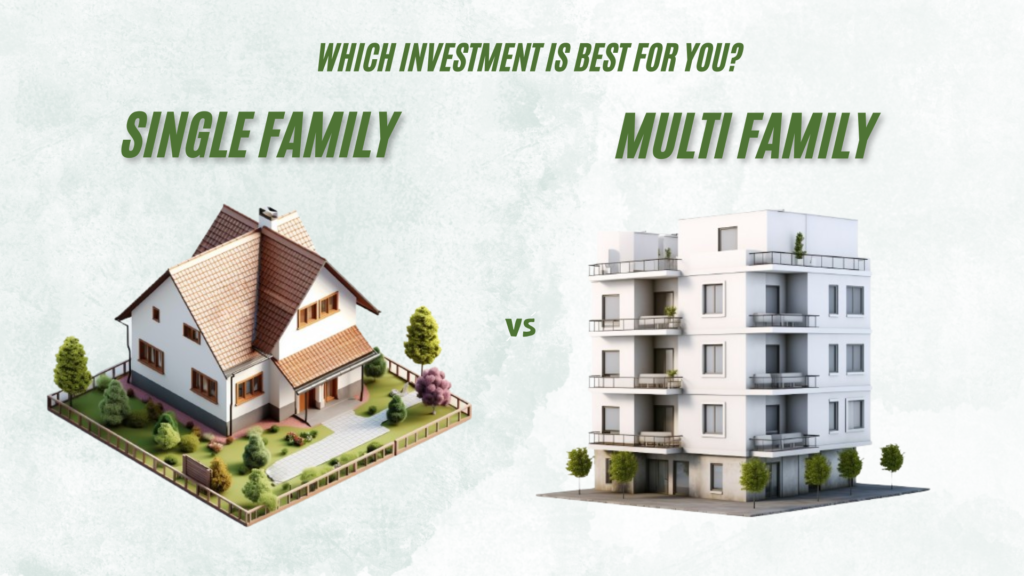Single Family vs Multi Family Investments: Which is Best for You?

A calculated approach to create wealth is real estate investment; rental properties provide a consistent stream of passive income. Investors weighing single-family against multi-family rents must take long-term profitability, management duties, and cash flow into account as well. The main variations between different property kinds are investigated in this paper to guide investors in choosing the best one.
Understanding Multi-Family and Single-Family Properties
A Single-Family rental is a stand-alone home intended for one tenant or family. Its own land, utilities, and entry let renters have privacy and a conventional house feel.
Multiple units housed within a single building or complex—such as duplexes, triplexes, apartment complexes, and townhouses—make up a multi-family rental. These features allow several renters, so providing investors with varied income sources.
Initial Outlay and Financial Concerns
Generally speaking, single-family residences demand less initial outlay than multi-family buildings. Their great availability and experience with mortgage lenders help to make funding easy. Since Single-Family rents need less capital and reduce risk, many first-time investors begin with them.
Conversely, multi-family homes sometimes need more initial expenses. Investors can, however, use commercial loans—based more on the earning potential of the property than on personal creditworthiness. Multi-family investment buildings provide more scalability even if the financing procedure can be more complicated.
Income Prospective and Cash Flow
Multi-family rentals offer one of the main benefits in terms of possible cash flow. Investors can keep consistent income even if some of the several rental properties are empty while others bring income. By means of diversity, financial risk is reduced, and a more constant return on investment (ROI) is guaranteed.
Since Single-Family rentals depend on a single tenant, they could have smaller cash flow. Single-Family Rental’s do, however, generally draw long-term renters, which lowers vacancy rates and generates consistent revenue. Given their greater resale value and market demand, single-family homes may appeal to investors looking for appreciation over time.
Maintenance and Properties Management
For hands-on investors or those wishing to self-manage, single-family homes are simpler to handle. Maintenance calls are fewer than those of multi-family buildings, and tenant interactions are simpler.
Still, multi-family leases call for more careful supervision. Landlords have to manage several leases, maintenance calls, and tenant issues concurrently. Often times, hiring a property management company helps to simplify processes, which increases the general running costs.
Tenants’ Stability and Occupancy Rates
Single-family homes often draw long-term renters who value stability—families and professionals included. Decreasing turnover rates as a result help to decrease income loss connected to vacancy.
Shorter lease terms—especially in apartment buildings—cause multi-family properties to see more turnover. Multiple units, however, guarantee that the business keeps making money even if some tenants move out from occupied spaces.
Appreciation of Market Demand
Since their value is determined by residential market movements, single-family homes frequently appreciate quicker than multi-family buildings. Both investors and owner-occupants find these properties appealing, hence they are simpler to sell in a favorable state of market conditions.
Based on their rental income potential, multi-family homes value. Their value is connected to occupancy rates, rental increases, and market demand for rental units even if it is rising gradually. Those that give long-term wealth creation top priority could gain from continuous revenue from multi-family homes.
Economic Resilience and Risk Factors
Single-family homes may be more vulnerable to vacancy during recessionary times when renters give cost top priority. Still in demand, nevertheless, well-located SINGLE-FAMILY RENTALs appeal to both tenants and homeowners.
Since they appeal to a larger tenant base, multi-family rents are more robust throughout economic times. Still a need for affordable housing, multi-family homes offer reasonably priced living quarters. Multiple units help to distribute the risk, therefore lessening the effect of vacancies.
Tax Returns and Depreciation
Tax benefits abound for single-family and multi-family homes from property expense write-offs to mortgage interest deductions to depreciation deductions. Still, multi-family investment usually gain more from increased depreciation limits and the opportunity to distribute deductions among several units.
Which Investment Strategy Makes Sense?
An investor’s financial goals, risk tolerance, and managerial capacity will determine whether single-family or multi-family rentals best fit them.
• Single-Family rentals Perfect for:
o First-time participants seeking a low-risk starting point
o Those looking for consistent renters and long-term appreciation
o Individuals who would rather practice minimum maintenance self-management
• Ideal for: multi-family rentals
o Investors concentrated on maximizing income diversity and cash flow.
o Those who either hire a professional management business or practice active property management
o Investors looking for tax benefits and scale.
Conclusion
Renting either single-family or multi-family homes has special benefits and drawbacks. While individuals looking for better income potential and scalability may find multi-family houses more appropriate, investors wanting consistent appreciation and minimal management may choose single-family homes. Investors can make calculated judgments to maximize returns in real estate by assessing financial goals and market conditions.
FAQ’s
How does single-family vary from multi-family?
Whereas multi-family residences have several rental units inside the same building or complex, single-family homes house one tenant or family in a standalone apartment.
What does single-unit family mean?
Designed for one renter or family, a single-unit family is a residence providing private living space and conveniences.
Apart from multi-family investing, what distinguishes flipping?
While multi-family investment concentrates on collecting rental homes to create continuous passive income, flipping is buying, refurbishing, and selling real estate for profit.
Describes a single-family style.
Single-family type homes, townhouses, or apartments used as stand-alone residences for one family or tenants are detached residential buildings.
Which is better—single-family or multi-family real estate?
The best choice relies on personal investing objectives. While multi-family homes give more income flow and scalability, single-family homes give stability and appreciation. Choosing between the two requires investors to evaluate their management tastes, financial resources, and risk tolerance.